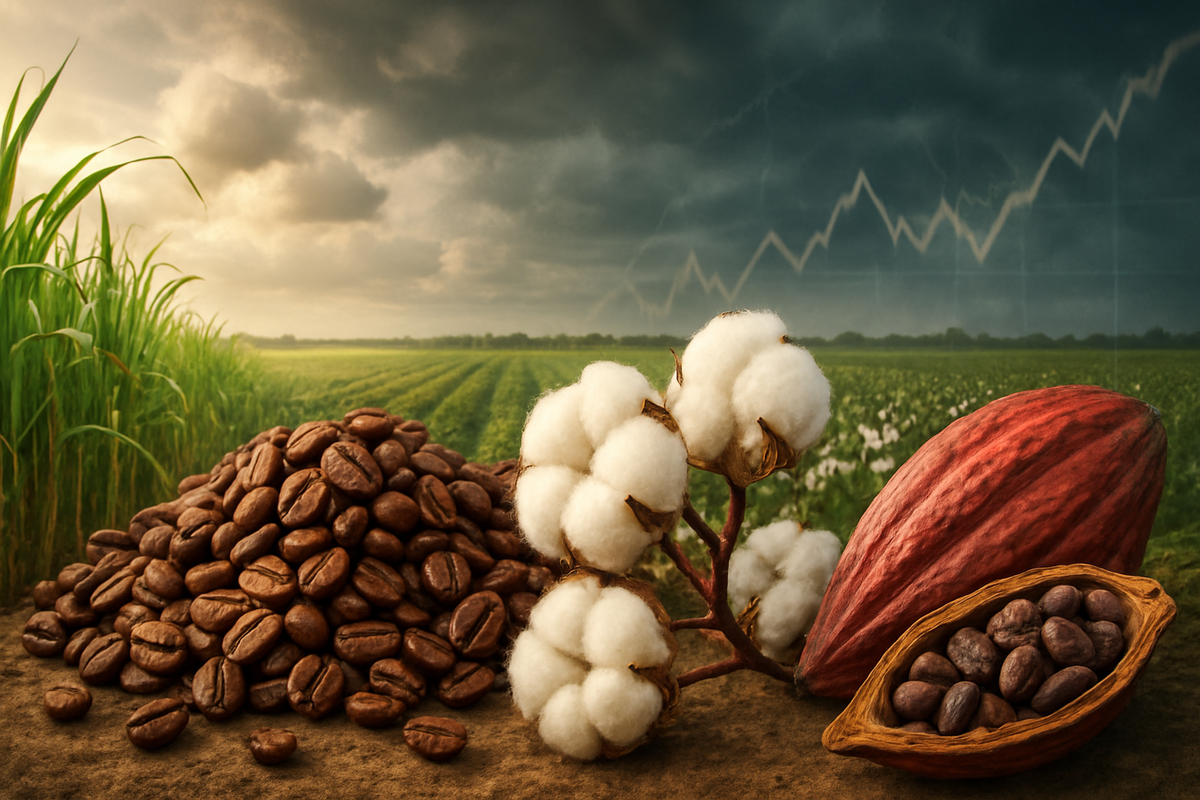
The global soft commodities market, encompassing the vital staples of sugar, coffee, cotton, and cocoa, is currently navigating a period of profound volatility and shifting dynamics as of late 2025. A complex interplay of extreme weather patterns, evolving global supply and demand metrics, macroeconomic headwinds, and geopolitical uncertainties are collectively shaping the future price trajectories of these essential agricultural goods. While some commodities like sugar are facing downward price pressures due to anticipated bumper harvests, others, notably coffee and cocoa, have experienced dramatic price swings driven by acute supply shortages and subsequent demand adjustments.
This intricate landscape presents both challenges and opportunities for producers, manufacturers, and consumers worldwide. The resilience of global supply chains is being tested by unprecedented climate events, while economic slowdowns in key regions are tempering demand for certain goods. The ongoing rebalancing of these forces suggests a period of continued flux, requiring close monitoring by all stakeholders as the market seeks equilibrium amidst these powerful influences.
Detailed Market Dynamics: A Commodity-by-Commodity Breakdown
The year 2025 has unfolded with distinct narratives for each of the major soft commodities, reflecting a complex tapestry of localized and global influences.
Sugar: The sugar market has experienced a notable easing of prices, with futures contracts trending downwards to levels not seen since early 2021. This decline is predominantly fueled by expectations of robust global supplies for the 2025/2026 harvest season. Brazil, the world's largest sugar producer, is concluding another substantial harvest, with its Center-South region showing significant year-on-year increases in output. Forecasts for Brazil's 2026/2027 sugar production even anticipate a record high. Complementing this, favorable monsoon rains and expanded cultivation areas in India and Thailand are contributing to an optimistic supply outlook. The USDA projects global 2025/2026 sugar production to surge by 4.7% year-on-year, reaching an unprecedented 189.318 million metric tons (MMT). While global consumption is also expected to rise, the booming corn ethanol production in Brazil is making corn-based ethanol a more cost-effective alternative, leading sugarcane mills to divert more of their crop towards sugar production rather than ethanol, thereby bolstering supply and exerting downward pressure on prices.
Coffee: The coffee market has been a hotbed of volatility, with Arabica bean prices at one point reaching highs not observed since 1977. This surge was initially driven by significant supply challenges, particularly due to adverse weather conditions in major producing regions. Vietnam (Robusta) and Brazil (Arabica) both faced periods of unfavorable weather, leading to reduced crop estimates, with Brazil's crop forecasting agency, Conab, cutting its 2025 Arabica coffee crop estimate. However, easing weather risks in these key producing nations are now starting to exert downward pressure on prices. The USDA's FAS projects a 2.5% year-on-year increase in world coffee production for 2025/2026, reaching a record 178.68 million bags, with Robusta production in Vietnam specifically expected to hit a four-year high. Despite this, Volcafe projects a global 2025/2026 Arabica coffee deficit of 8.5 million bags, marking the fifth consecutive year of deficits, indicating that while overall supply might improve, specific bean types could remain tight. Structural tightening of Robusta supply, partly due to shipping delays and farmers in Vietnam withholding beans, has also pushed prices to multi-year highs.
Cotton: The cotton market continues to face a challenging environment, with prices remaining subdued amidst a delicate balance of supply and demand factors. Global cotton production for 2025/2026 is forecast to see a slight decrease of 1.3% from the previous year, settling at 117.7 million bales. This reduction is primarily attributed to lower production estimates in the United States and Australia. U.S. production for the 2025/2026 season is anticipated to decline by 8% below the prior year, with planted acreage projected at a low 9.3 million acres, influenced by relatively low price expectations and competition from other crops. On the demand side, global mill use is projected to marginally decrease by less than 0.5% to 118.8 million bales, with declines in China and Turkey partially offset by gains elsewhere. China remains the largest consumer of raw cotton. The broader economic slowdown is expected to tighten consumer spending on discretionary items, thereby impacting textile demand. High input costs coupled with subdued cotton prices continue to squeeze producers, while trade uncertainties and policy shifts remain significant high-risk factors for this export-dependent market.
Cocoa: The cocoa market has experienced a rollercoaster ride, with prices recently plunging after reaching unprecedented historical highs. The initial surge was a direct consequence of severe supply shortages stemming from poor growing conditions in West Africa, which accounts for over 70% of global cocoa production. Issues such as El Niño-induced weather extremes, the devastating swollen shoot virus, and compromised bean quality in Côte d'Ivoire led to a projected 20% drop in its mid-crop from historical norms for the 2023/2024 season. Cocoa futures peaked over $12,000/MT in December 2024 and traded consistently around $10,000/MT in early 2025. However, prices have since fallen below $8,000/tonne by August 2025. This correction is largely due to expectations of increased production in the 2025/2026 season, with improved weather conditions and expansion in Indonesia, Nigeria, Brazil, and Ecuador. Furthermore, weakening industrial demand, evidenced by falling European, Asian, and North American cocoa grindings in Q4, indicates that manufacturers are grappling with higher input costs, leading to softer demand.
Corporate Fortunes in Flux: Winners and Losers in the Soft Commodities Arena
The dynamic shifts within the soft commodities market in late 2025 are poised to significantly impact the financial performance of various public companies, creating both opportunities for improved profitability and considerable headwinds for others. The prevailing trends suggest a clear divergence in fortunes based on whether a company is a net producer or consumer of these agricultural goods.
Sugar Market Dynamics: With global sugar supplies projected to be robust and prices retreating to multi-year lows, companies that are major consumers of sugar stand to benefit substantially. Confectionery giants such as The Hershey Company (NYSE: HSY), Mondelez International (NASDAQ: MDLZ), Nestlé (OTC: NSRGY), and Tootsie Roll Industries (NYSE: TR) are likely to experience a significant "win" as their primary input costs for sugar decline. This reduction in raw material expenses could directly translate into improved profit margins, bolstering their bottom lines, especially if consumer demand for their popular snack and beverage products remains resilient. Conversely, major sugar producers and exporters, like Brazilian conglomerate Cosan (NYSE: CSAN) and agricultural firm Adecoagro (NYSE: AGRO), face potential revenue and profit margin compression. While Cosan's diversified operations in sugarcane ethanol might offer some buffer if ethanol demand is strong, the overall low sugar prices will challenge the profitability of their core sugar divisions. Diversified agribusinesses like Bunge Limited (NYSE: BG) might see mixed impacts, with their sugar segment facing pressure but potentially offset by other commodity operations.
Coffee Market Challenges: The coffee market's sustained high prices and notable volatility present a significant challenge for coffee retailers and manufacturers. Global giants such as Starbucks Corporation (NASDAQ: SBUX), Nestlé (OTC: NSRGY) with its Nescafé and Nespresso brands, The J.M. Smucker Company (NYSE: SJM) (Folgers, Dunkin' coffee), and Keurig Dr Pepper Inc. (NASDAQ: KDP) will continue to grapple with elevated green coffee input costs. This pressure on raw material expenses could squeeze profit margins, forcing companies to either absorb costs, pass them on to consumers through higher prices (potentially impacting sales volume), or seek operational efficiencies. Rapidly expanding chains like Dutch Bros Inc. (NYSE: BROS) and wholesalers like Farmer Brothers Company (NASDAQ: FARM) are also exposed to these rising costs, which directly impact their operational expenses and wholesale margins. However, strong brand loyalty, growth in emerging markets, and increasing demand for specialty and convenient coffee options could provide some resilience for these players.
Cotton Market Headwinds: The subdued outlook for cotton prices, coupled with sluggish global economic growth impacting consumer demand for textiles and apparel, creates a challenging environment for companies across the cotton value chain. While lower raw cotton prices could be a marginal "win" for fabric mills like Crown Crafts, Inc. (NasdaqCM: CRWS) and Culp, Inc. (NYSE: CULP) by reducing their input costs, this benefit is likely to be overshadowed by weak consumer demand, potentially leading to lower sales volumes or pressure on finished product pricing. Agricultural machinery manufacturers like Deere & Company (NYSE: DE) could face indirect losses as constrained profitability for cotton farmers, due to low prices and high input costs, might lead to reduced investment in new equipment. Diversified agribusinesses such as Archer-Daniels-Midland Company (NYSE: ADM) might see their cotton segments underperform, though their broad portfolio could mitigate overall impact.
Cocoa Market Rebalancing: After reaching unprecedented highs in late 2024, cocoa prices have experienced a significant plunge by late 2025, offering a substantial "win" for chocolate and confectionery manufacturers. Companies like The Hershey Company (NYSE: HSY), Mondelez International (NASDAQ: MDLZ), Nestlé (OTC: NSRGY), Chocoladefabriken Lindt & Sprüngli AG (OTC: LDSVF), Rocky Mountain Chocolate Factory, Inc. (NASDAQ: RMCF), and Tootsie Roll Industries, Inc. (NYSE: TR) will benefit from significantly lower cocoa input costs. This reduction can lead to improved profit margins and alleviate the pressure to raise product prices, potentially supporting sales volumes that may have been affected by earlier high prices. While J.P. Morgan still anticipates cocoa prices to remain structurally elevated around $6,000/tonne into 2026 compared to historical averages, the current easing is a welcome relief after the extreme highs. However, any unexpected rebound in prices due to unforeseen supply disruptions could quickly reverse these gains.
In essence, the late 2025 soft commodities market is shaping up to be a period where the cost of raw materials will be a primary determinant of corporate profitability, favoring those on the consumption side of sugar and cocoa, while challenging producers and coffee-centric businesses.
Broader Implications: A Shifting Global Landscape
The current trends in the soft commodities market are not isolated events but rather integral components of broader, transformative shifts occurring within the global economy and environment. The volatility observed across sugar, coffee, cotton, and cocoa in late 2025 underscores a fundamental reordering of priorities, moving from pure cost-efficiency to an imperative for supply chain resilience and adaptation in the face of unprecedented challenges.
Fitting into Broader Industry Trends: The fluctuating prices of soft commodities are a microcosm of the wider global commodity market volatility. This instability is exacerbated by persistent geopolitical tensions, divergent monetary policies across major economies, and ongoing supply chain disruptions. The World Bank's agricultural price index, which has seen a decline of nearly 7% since early 2025, projects further decreases into 2026, though individual crop movements often defy this general trend. For the food and beverage industry, these dynamics translate into increased input costs, potentially eroding profit margins or necessitating higher retail prices for consumers. This pushes companies to diversify their supply chains and adopt robust commodity hedging strategies to mitigate risk. Similarly, the textile industry is navigating a complex environment where raw material costs, particularly for cotton, are influenced by both supply-side shocks and fluctuating consumer demand for apparel.
Ripple Effects on Competitors and Partners: The heightened volatility compels companies across various sectors to re-evaluate their supply chain strategies. A global pivot towards resilience means that businesses with diversified sourcing and robust logistical networks are better positioned to weather regional crop failures or geopolitical disruptions. This creates a competitive advantage for agile players and puts pressure on those with concentrated supply lines. Furthermore, rising commodity costs contribute directly to inflationary pressures, impacting consumer purchasing power and influencing central bank monetary policies. Agribusiness giants involved in origination, processing, and merchandising find their profitability intrinsically linked to these supply-demand imbalances and price fluctuations, while consumer goods companies face the constant challenge of balancing rising input costs with consumer affordability.
Regulatory and Policy Implications: Governments worldwide are increasingly intervening in commodity markets through protectionist trade policies, including tariffs, export controls, and investment screening. Examples include potential US-China tariff threats, which can trigger immediate supply chain adjustments and market volatility. The critical role of accurate data was highlighted by a U.S. government shutdown in October 2025, which caused a blackout of vital agricultural data during peak harvest season, intensifying market speculation. International regulations, such as the EU's anti-deforestation law, postponed to December 2025, are also set to influence commodity prices, particularly for coffee and cocoa, as traders adjust their inventories ahead of its implementation. Central banks are also beginning to factor climate change into their policy considerations, debating whether to adopt more flexible inflation targets to accommodate climate-induced supply shocks.
Historical Precedents and Comparisons: While the magnitude of recent price surges in soft commodities might seem unprecedented, historical parallels can be drawn to periods like 1971-74 and 1994-96, which also saw rapid increases in crop prices driven by strong global demand, supply shocks, and currency depreciation. Historically, market adjustments eventually brought prices down, but the current environment is arguably more volatile due to the confluence of factors. Geopolitical tensions have consistently introduced a "war premium" to commodity prices, with nations competing for critical resources – a phenomenon strongly evident today with ongoing conflicts and trade disputes. These historical cycles underscore the inherent volatility of commodity markets, where inventory levels and specific demand shocks are crucial drivers of price fluctuations.
The Overarching Impact of Climate Change and Geopolitics: Climate change remains the single most significant long-term factor shaping the soft commodities market. Extreme weather events, from El Niño-induced droughts to heavy rainfall and higher temperatures, are directly impacting crop yields for coffee and cocoa, causing sudden and unpredictable price spikes. This necessitates accelerated investment in drought-resistant crops, precision agriculture, and sustainable farming methods. Geopolitical factors, however, are the dominant short-term drivers of volatility in late 2025. Ongoing conflicts, trade disputes, and the rise of resource nationalism are disrupting trade routes, increasing shipping costs, and leading to strategic competition for essential resources, including agricultural commodities. The interplay of these powerful forces means that the soft commodities market will likely remain highly unpredictable for the foreseeable future, demanding continuous adaptation from all participants.
What Comes Next: Navigating the Future of Soft Commodities
The soft commodities market in late 2025 and into 2026 is poised for a period of dynamic evolution, characterized by a persistent tug-of-war between robust demand growth, particularly in emerging markets, and significant supply-side vulnerabilities driven by climate change and geopolitical factors. This intricate balance will necessitate strategic agility and foresight from all market participants.
Short-Term and Long-Term Possibilities: For coffee, global consumption is projected to reach record highs, driven by burgeoning demand in Asia-Pacific, the Middle East, and especially China. Short-term, prices are expected to remain elevated and volatile due to tight stocks and ongoing supply concerns from adverse weather in Vietnam and Brazil, potentially marking a fifth consecutive deficit year. Long-term, while some analysts foresee a normalization of prices by 2026 as output recovers in Colombia and Brazil, the overall market is projected for substantial growth, fueled by the expanding global coffee culture.
Cocoa has seen recent price declines from historical highs, largely due to "demand destruction" and improving supply expectations for the 2025/2026 season from improved weather and expansion in Ecuador. However, renewed supply concerns in West Africa could provide short-term support. Long-term, the cocoa market is forecast for significant growth, driven by increasing demand for chocolate and cocoa derivatives, alongside a growing emphasis on sustainable and traceable sourcing.
The cotton market in late 2025 and 2026 faces strong harvests but uncertain demand. Short-term, prices are expected to decline due to ample supply and subdued demand, with declining U.S. production creating export opportunities for Brazil and Australia. Long-term, while modest price recovery is anticipated, overall supply remains robust, and global trade is expected to recover, particularly with increased mill use in emerging textile-producing countries.
Sugar is entering 2025/2026 with expectations of increasing global supplies, notably from Brazil and India, which will likely exert downward pressure on prices. However, differing forecasts exist regarding a potential global deficit or surplus. Long-term, Brazil's production is expected to continue growing, with farmers investing in expanded sugarcane planting areas.
Strategic Pivots and Adaptations: Market participants will need to prioritize supply chain diversification and resilience, moving away from concentrated sourcing to mitigate risks from localized crop failures and trade disruptions. Data-driven decision-making and robust risk management strategies, including hedging, will become even more critical for navigating price volatility. The growing consumer demand for ethically produced goods will necessitate a stronger focus on sustainability and traceability across all soft commodities. Furthermore, innovation in farming technology, such as drought-resistant crops and precision agriculture, will be crucial for maintaining yields in the face of climate change. For sugar, the flexibility to diversify product output between sugar and ethanol based on market profitability will remain a key strategic lever.
Emerging Market Opportunities and Challenges: Opportunities abound in the Asia-Pacific region, where rising disposable incomes and evolving lifestyles are fueling significant demand growth for coffee and cocoa. The global expansion of coffee culture also presents avenues for growth. Conversely, climate change and weather volatility remain persistent challenges, causing unpredictable supply shocks. Geopolitical risks and trade policies continue to introduce uncertainty, potentially impacting demand and creating price volatility. The phenomenon of "demand destruction" due to high prices (as seen in cocoa) and the substitution by synthetic fibers (for cotton) are also significant challenges. Finally, currency fluctuations, particularly the strength of the US dollar, can add pressure to dollar-denominated commodity contracts.
Potential Scenarios and Outcomes:
- "Growth with Volatility" Scenario: Moderate global economic growth sustains demand, but supply remains vulnerable to extreme weather and regional issues, leading to continued price swings. Companies will need flexible supply chains and robust hedging.
- "Supply Rebound & Price Normalization" Scenario: Favorable weather and improved agricultural practices lead to strong harvests, alleviating supply constraints and moderating prices. The focus shifts to cost efficiency and market share.
- "Climate Crisis & Elevated Prices" Scenario: More frequent and severe extreme weather disrupts production across multiple regions, leading to sustained high prices, potentially new records for coffee and cocoa. Urgent adaptation strategies and climate-resilient farming become critical.
- "Global Economic Slowdown" Scenario: A significant global downturn dampens consumer spending and industrial demand, overriding some supply-side issues and leading to price moderation or declines. Companies will focus on cost-cutting and targeting resilient consumer segments.
The soft commodities market in the coming months will be a testament to the interplay of natural forces, human ingenuity, and global economic currents. Adaptability and a deep understanding of these complex dynamics will be paramount for success.
Comprehensive Wrap-up: Navigating a New Era for Soft Commodities
The soft commodities market in late 2025 presents a nuanced and often contradictory picture, characterized by both unprecedented challenges and emerging opportunities. The overarching theme is one of heightened volatility, driven primarily by the increasingly unpredictable impacts of climate change on agricultural yields and the persistent undercurrents of geopolitical instability and macroeconomic shifts.
Key Takeaways:
- Divergent Trends: While sugar faces downward price pressure due to strong harvests, coffee remains elevated and volatile, and cocoa has seen a sharp correction after reaching record highs. Cotton prices are subdued amidst weak demand.
- Climate Change as a Primary Driver: Extreme weather events are no longer anomalies but consistent disruptors, directly impacting crop yields and introducing significant supply-side uncertainty for all soft commodities.
- Geopolitical and Economic Headwinds: Trade policies, central bank actions, and regional conflicts continue to add layers of complexity, influencing everything from supply chain logistics to consumer purchasing power.
- Corporate Impact: Net consumers of sugar and cocoa stand to benefit from lower input costs, while producers and coffee-centric businesses face significant margin pressures.
- Demand Resilience in Emerging Markets: Despite price volatility, global demand for coffee and cocoa, particularly in Asia-Pacific, continues to show robust growth, signaling long-term market expansion.
Assessment of the Market Moving Forward: The market is in a continuous state of rebalancing. While some commodity prices may normalize as supply recovers, the underlying structural issues, particularly climate change, suggest that periods of intense volatility will be a recurring feature. The emphasis for market participants is shifting from purely optimizing cost to building resilient and adaptable supply chains. This includes diversifying sourcing, investing in advanced farming technologies, and adopting comprehensive risk management strategies. The interplay between traditional agricultural practices and modern technological solutions will define success.
Significance and Lasting Impact: The current environment is not merely a cyclical downturn or upturn; it represents a fundamental recalibration of how global agricultural markets operate. The lasting impact will be a permanent shift towards more localized, sustainable, and transparent sourcing. Furthermore, the increasing integration of climate risk into financial models and policy decisions will profoundly reshape investment and operational strategies across the sector. This era demands a holistic approach, recognizing that environmental, social, and governance (ESG) factors are no longer peripheral but central to long-term market stability and profitability.
What Investors Should Watch For: Investors should closely monitor several key indicators in the coming months:
- Weather Patterns: Pay close attention to meteorological forecasts and their actual impact on crop-producing regions for all four commodities, especially in Brazil (sugar, coffee), Vietnam (coffee), and West Africa (cocoa).
- Trade Policies and Geopolitical Developments: Any new tariffs, export restrictions, or escalations in geopolitical conflicts could trigger immediate and significant price swings.
- Inflationary Pressures and Consumer Demand: Track global inflation rates and consumer spending habits, particularly for discretionary items like chocolate and specialty coffee, as these will directly influence demand.
- Company Financial Reports: Analyze the earnings reports of major producers and consumers of these commodities for insights into their cost management, supply chain resilience, and profit margins.
- Technological Innovations: Watch for advancements in agricultural technology, such as drought-resistant crops or precision farming, which could offer long-term solutions to supply volatility.
- Sustainability Initiatives: Observe the adoption and impact of sustainable sourcing and traceability initiatives, as these will increasingly influence consumer preference and regulatory compliance.
This content is intended for informational purposes only and is not financial advice.






